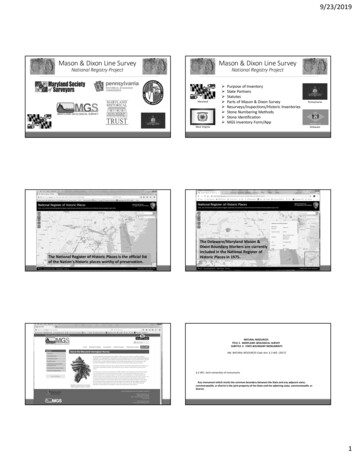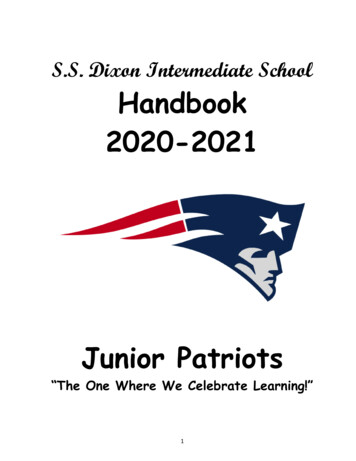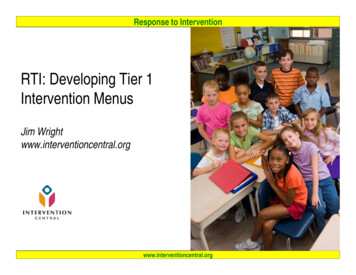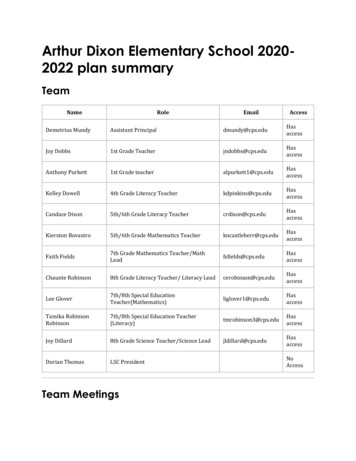
Transcription
Arthur Dixon Elementary School 20202022 plan summaryTeamNameRoleEmailAccessDemetrius MundyAssistant Principaldmundy@cps.eduHasaccessJoy Dobbs1st Grade Teacherjndobbs@cps.eduHasaccessAnthony Purkett1st Grade teacheralpurkett1@cps.eduHasaccessKelley Dowell4th Grade Literacy Teacherkdpinkins@cps.eduHasaccessCandace Dixon5th/6th Grade Literacy Teachercrdixon@cps.eduHasaccessKierston Bovastro5th/6th Grade Mathematics Teacherkncastleberr@cps.eduHasaccessFaith Fields7th Grade Mathematics Teacher/MathLeadfsfields@cps.eduHasaccessChaunte Robinson8th Grade Literacy Teacher/ Literacy Leadcerobinson@cps.eduHasaccessLee Glover7th/8th Special ccessTamika RobinsonRobinson7th/8th Special Education Teacher(Literacy)tmrobinson3@cps.eduHasaccessJoy Dillard8th Grade Science Teacher/Science Leadjldillard@cps.eduHasaccessDorian ThomasLSC PresidentTeam MeetingsNoAccess
DateParticipantsTopic01/29/2020Demetrius Mundy, Anthony Purkett, KelleyDowell, Candance Dixon, Faith Fields, ChaunteRobinson, Lee Glover, Tamika Robinson, JoyDillard, Terrycita PerryCIWP School Excellence FrameworkWork sheet02/12/2020Demetrius Mundy, Anthony Purkett, MarthaFowler, Kelley Dowell, Candance Dixon, FaithFields, Chaunte Robinson, KierstonBovastro,Lee Glover, Tamika Robinson, JoyDillard, Terrycita PerryDiscussed the school data by looking atcurrent trends, analysis of SQRP,leadership, and instructional core andidentify our 3 areas of critical need02/21/2020Demetrius Mundy, Joy Dobbs, AnthonyPurkett, Kelley Dowell, Candance Dixon, FaithFields, Chaunte Robinson, Lee Glover, TamikaRobinson, Kierston Bovastro, Joy Dillard,Terrycita PerryFinalized the goal section by selectingthree metrics and providing a goal foreach.03/11/2020Demetrius Mundy, Anthony Purkett, MarthaFowler, Kelley Dowell, Candance Dixon, FaithFields, Chaunte Robinson, KierstonBovastro,Lee Glover, Tamika Robinson, JoyDillard, Terrycita PerryCIWP members began working on theroot cause analysis03/26/2020Demetrius Mundy, Joy Dobbs, AnthonyPurkett, Kelley Dowell, Candance Dixon, FaithFields, Chaunte Robinson, Lee Glover, TamikaRobinson, Joy Dillard, Terrycita PerryCompleted the root cause analysisprotocol04/03/2020Demetrius Mundy, Joy Dobbs, AnthonyPurkett, Kelley Dowell, Candance Dixon, FaithFields, Chaunte Robinson, Lee Glover, TamikaRobinson, Joy Dillard,Finalized the Root cause analysis andcreated 3 priorities for the SY20 -2204/17/2020Demetrius Mundy, Anthony Purkett, MarthaFowler, Kelley Dowell, Candance Dixon, FaithFields, Chaunte Robinson, KierstonBovastro,Lee Glover, Tamika Robinson, JoyDillard, Terrycita PerryCIWP team finalized the Theory of Actionand Action steps04/24/2020Demetrius Mundy, Anthony Purkett, MarthaFowler, Kelley Dowell, Candance Dixon, FaithFields, Chaunte Robinson, KierstonBovastro,Lee Glover, Tamika Robinson, JoyDillard,Finalized the Theory of Action andAction steps05/07/2020Demetrius Mundy, Anthony Purkett, CandanceDixon, Faith Fields, Lee Glover, TamikaRobinson, Joy Dillard, Dorian ThomasCompleted the Fund Compliance sectionand Parent and Family Plan of the CIWPand to revisit the Theory of Action andAction Steps to make some neededchanges
FrameworkCategory scoring 1 NONE or FEW of the practices are CONSISTENTLY evident.2 FEW of the practices are CONSISTENTLY evident for FEW students and/or staff.3 MOST of the practices are CONSISTENTLY evident for SOME students and/or staff.4 Nearly ALL practices are CONSISTENTLY evident for ALL students and/or staff.Subcategory scoring 1 Practice is not consistently evident for ANY students and/or staff.2 Practice is CONSISTENTLY evident for FEW students and/or staff.3 Practice is CONSISTENTLY evident for SOME students and/or staff.4 Practice is CONSISTENTLY evident for ALL students and/or staff.Not scoredLeadership and Structure for Continuous Improvement 3 - Leadership for Continuous Improvemento 3 Set the direction and create a sense of purpose by building consensus on andimplementing a shared visiono 3 Inspire a culture of collective responsibility for ALL students to succeed and forbuilding a safer and more supportive environment throughout the school, not justin their own classrooms (REQUIRED: OSEL)o 3 Empower others to make or influence significant decisions (REQUIRED: OSEL)o 3 Enable staff to focus and prioritize what matters mosto 3 Employ the skills to effectively manage changeo 3 Make ?safe practice? an integral part of professional learningo 3 Collaborate, value transparency, and inform and engage stakeholderso Evidence: Evidence is perceivable through weekly updates, grade levelmeetings, off track data and ILT meetings3 - Structure for Continuous Improvemento 3 Engage in ongoing inquiry (e.g. continuous improvement cycles) as a basis forimprovemento 3 Build the capacity of teacher teams to lead cycles of learning and problemsolving focused on student learning data and student worko 3 Design professional learning (PL) to achieve school-wide improvement goalso 3 Design and implement school day schedules that are responsive to studentneedso 3 Align the budget to the CIWP priorities and the mission of the schoolo 3 Strategically hire, assign, and retain teachers to create balancedgrade/content teams with a variety of strengths to ensure all students haveequitable access to high-quality teacherso 2 The local school council (LSC) or another community oversight committee ofboard is actively and productively involved in supporting SEL initiatives andimprovements to school climate (REQUIRED: OSEL)o 3 Physical surroundings convey a positive, student-centered school environment(REQUIRED: OSEL)o Evidence: Evidence is visible throughout the use of teacher teams: grade levelteams, ILT, and content area teams. These teams are responsible for analyzing
the data that is pulled from various sources such as student work, NWEA learningcontinuum, Study Island, IXL, reading Eggs, RAZ kids and etc. to support teacherinstruction that will provide positive outcomes and opportunities for studentsachievement.Depth and Breadth of Student Learning and Quality Teaching 3 - Curriculumo 3 Provide culturally relevant/sustaining curriculum that provides opportunities toexplore and celebrate student's communities, culture, history, and languageo 3 Utilize the ?big ideas? that should be taught to determine whether students arebeing taught the body of knowledge, the understandings, and the skills expectedo 3 Curriculum connects to real world, authentic application of learningo 3 Curriculum is aligned to expectations of the standardso 2 Integrate the teaching of academics and the ISBE Social Emotional LearningStandards (REQUIRED: OSEL)o 3 Expand access to diverse, contemporary well-stocked text collections thatprovide opportunities for all students to engage with text from a wide range ofgenres, including text of appropriate grade level complexityo Evidence: Evidence is shown through the use of the network scope andsequence which is aligned to the common core standards where teachers use asa guide to support instruction and activities are implemented to provide thosereal world experiences for the students. SEL is integrated through the use of PBISwhere core values are taught to the students. The core values are to beresponsible, respectful in in control at all times.2 - Instructiono 3 Create a culture that reflects high expectations for all students and enablespractice and perseverance for each individual student (REQUIRED: OSEL)o 2 Engage students in learning and foster student ownershipo 2 Use questioning and discussion as techniques to deepen student understandingo 3 Plan and assign tasks that are cognitively challenging for individual studentsand require students to provide evidence of their reasoningo 3 Provide students frequent, informative feedbacko 2 Persist in adjusting instruction so individual student misunderstandings oradvanced needs are successfully accommodatedo 2 Engage all learners in content areas by differentiating and fully integratingopportunities for all learnerso 3 Tasks convey the key shifts and practices of the discipline. (See departmentalguidance for Arts Education, Health and Physical Education, Literacy, Math,Science, Social Science & Civic Engagement)o Evidence: The use of the gradual release of responsibility is used throughout theschool to maximize teacher instruction and student ownership.3 - Balanced Assessment and Gradingo 3 School-based teams discuss and monitor the effect of teaching on studentlearning, integrate formative assessment into instruction and intervention ofindividual studentso 3 Use multiple measures (i.e. a range of assessment types and at multiple points intime) to supplement district-centralized assessments with other formativeassessments to provide a more comprehensive picture of student learningo 3 ILT, GLT, and interventionists use a Problem Solving Process approach toscreening, diagnostic, and progress monitoring assessments to identify specificgaps and monitoring improvement for students within all tiers
3 Make assessments accessible to students, including diverse learners and EnglishLearners through employing features of universal design and use ofaccommodations and, where needed, modificationso 3 Utilize assessments that reflect the key shifts in content areas in teacher createdor selected assessmentso 3 Utilize assessments that measure the development of academic language forEnglish learnerso 2 Have access to and analyze school-wide, teacher team, and classroomassessment data to determine instructional effectiveness, in house criteria, andsubsequent learning needso 3 Improve and promote assessment literacyo 3 Have a grading system that clearly, accurately, consistently, and fairlycommunicates learning progress and achievement to students, families,postsecondary institutions, and prospective employerso Evidence: Balanced assessment and grading was one of our priorities for theprevious CIWP. Assessments vary from teacher made, Study Island, CompassLearning, IXL and other resources that teachers use to create varied ways toassess students. ILT and GLT consistently bring assessments to critique and providefeed back. Feedback was based off effective use and balance of DOK questionstems. Teachers are also required to submit weekly assessments with lesson planswhere feedback is provided.2 - MTSSo 3 ON TRACK - Provide universal supports to prevent failing and absenteeism andtargeted interventions for grades below ?C? or chronic absenteeism (REQUIRED:MTSS)o 3 MTSS Team completes SEF ratings for MTSS subcategories (denoted as"REQUIRED MTSS") at MOY and EOY to reflect on MTSS fidelity of implementation(REQUIRED: MTSS)o 3 MTSS Team uses MTSS Framework Implementation Guide or other resources fromCentral Office to align priorities to outcomes (REQUIRED: MTSS)o 3 Administration supports MTSS Team with resources needed to make changes toframework/system (REQUIRED: MTSS)o 2 School tracks growth of ALL students, specifically students receiving Tier 2 andTier 3 supports based on district-wide available data to accurately assess studentachievement results and school practices (REQUIRED: MTSS & OSEL)o 3 Shared Leadership: Administration recruits a diverse MTSS core team (contentareas, counselors, etc.),or identifies an existing team that is responsible for drivingthe school?s MTSS Framework and Implementation (REQUIRED: MTSS & OSEL)o 3 Shared Leadership: MTSS Team uses multiple data sources to determine localTiering Criteria For Tier 1, Tier 2, Tier 3 interventions (REQUIRED: MTSS & OSEL)o 2 Shared Leadership: MTSS Team develops a Menu of Interventions that clearlyoutlines the supports, resources, system and structures for Tier 1, Tier 2, and Tier 3(REQUIRED: MTSS & OSEL)o 2 Shared Leadership: School Teams communicate MTSS related outcomes to allstakeholders (REQUIRED: MTSS & OSEL)o 2 Problem Solving Process: MTSS Team, teachers, and intervention providers usethe Problem Solving Process (PSP) to identify root causes and contributing factorsof deficit areas (REQUIRED: MTSS & OSEL)o 2 Problem Solving Process: MTSS Team gathers and utilizes multiple data sourcesto define the problems and take action for Tiers 1, 2, and 3 (REQUIRED: MTSS &OSEL)o 3 Curriculum and Instruction: Instructional staff provides culturally relevant, highquality, standards-aligned curriculum in which SEL instruction is embedded intocore content (REQUIRED: MTSS & OSEL)o
2 Curriculum and Instruction: Instructional staff provides differentiated instructionto meet the needs of all students (REQUIRED: MTSS)o 3 Curriculum and Instruction: Instructional staff provides interventions that areresearch-based (REQUIRED: MTSS & OSEL)o 3 Curriculum and Instruction: School Teams analyze data to prioritize opportunitiesto improve instruction, guide grouping, re-teaching and to identify/prioritizeinstructional needs (REQUIRED: MTSS)o 3 Progress Monitoring (PM): School identifies and uses a research-baseddiagnostic tool and process to determine root-cause and area of need for Tier 2and Tier 3 supports (REQUIRED: MTSS & OSEL)o 2 Progress Monitoring (PM): School Teams progress monitor and analyze studentresponse to intervention throughout the intervention cycle to determine andimplement needed adjustments (REQUIRED: MTSS & OSEL)o 2 Progress Monitoring (PM): MTSS Team clearly defines the method, duration,frequency, and measures for progress monitoring (REQUIRED: MTSS & OSEL)o 2 Family & Community Engagement: School establishes regular communicationwith families to build their understanding of MTSS, purpose of interventions andtiered support systems, and how it will support their child (REQUIRED: MTSS & OSEL)o 2 Family & Community Engagement: School teams develop a process ofcommunication for formally notifying parents/families when their child is selectedto receive Tier 2 or Tier 3 interventions (REQUIRED: MTSS & OSEL)o 2 Family & Community Engagement: Administration and school teams establishand continually evaluate community partnerships to support MTSSimplementation (i.e. providing Tier 2 or Tier 3 supports) (REQUIRED: MTSS & OSEL)o 2 Family & Community Engagement: School teams ensure that feedback/inputfrom families is taken into consideration during the PSP and intervention planning(REQUIRED: MTSS & OSEL)o 2 Family & Community Engagement: School engages families in supporting withprogress monitoring of their students (REQUIRED: MTSS & OSEL)o 3 Fidelity of Implementation: School teams utilize the SAM at BOY, MOY and EOYto reflect on MTSS fidelity of Implementation (REQUIRED: MTSS)o 3 Fidelity of Implementation: School teams use MTSS Framework ImplementationGuide and/or other resources from Central Office to align priorities to outcomes(REQUIRED: MTSS)o 3 Fidelity of Implementation: School teams leverage other self-reflectingprocesses such as the SEF or the CIWP to evaluate and improve MTSS frameworkand implementation (REQUIRED: MTSS)o 2 Fidelity of Implementation: Administration supports the fidelity of MTSS practices,principles, and resources needed to make suitable changes to systems andstructures (REQUIRED: MTSS)o Evidence: Evidence of MTSS are Goal setting sheets, NWEA RIT profile are senthome with students, Small group instruction, 8th grade students are tutoringprimary students in basic math facts, students are tired, programs such as Studyisland and IXL are used to progress monitor students growth and reteachingpractices are implemented.3 - Transitions, College & Career Access, & Persistenceo 3 TRANSITIONS - Have structures and processes in place to ensure successfultransitions (e.g. into school, grade to grade, school to school, school to postsecondary)o 3 AWARENESS - Expose students early to academic/professional worlds beyond K12o 3 READINESS ? Ensure equitable access to college preparatory curriculumo 3 SUCCESS - Provide direct assistance to all students and families through everystage of the college selection, application, and entry process (Transition too
oCollege (HS)) including, but not limited to academic planning/advising to assistwithEvidence: Evidence of college and career access is that the 7th and 8th gradeteachers provide SAT High school readiness vocabulary, The councilorconsistently monitors and assist 8th grade students with Go Cps and provide Highschool tours. We host our very own High School fair for 6th -8th grade studentsand provide a HBCU college tour for the 8th grade class.Quality and Character of School Life 3 - Relational Trusto 3 Foster respectful and supportive student-student interactions, with strong normsfor responsible behavior, to encourage a sense of belonging to the school andthe classroom community (REQUIRED: OSEL)o 3 Foster supportive, caring and respectful staff-student interactions, so that eachstudent has at least one trusted adult in the school (REQUIRED: OSEL)o 3 Adults support and respect one another, personally and professionally(Teacher-Teacher Trust, Teacher-Principal Trust) (REQUIRED: OSEL)o Evidence: Evidence is noticeable through the use of community building.Teachers began the year by participating in team building activities at Iron Oaks.Students build relationships with their class by participating in community projectssuch as creating a class room theme for the year, decorating their door with theirclass theme, Calm classroom is implemented daily as well as playing motivationalmusic in the morning. Students also recite a school pledge that focuses on theschools core values of being respectful, responsible and in control.2 - Student Voice, Engagement, and Civic Lifeo 3 Study politicso 3 Become informed voters and participants in the electoral processo 3 Engage in discussions about current and controversial issueso 2 Explore their identities and beliefs (REQUIRED: OSEL)o 2 Exercise student voice (REQUIRED: OSEL)o 3 Authentically interact with community and civic leaderso 3 Engage with their communityo 2 Take informed action where they work together to propose and advocate forsolutionso 2 Experience a schoolwide civics cultureo Evidence: Students are a part of student council as well as a functioning betaclub.The Mayor and his wife has visited the school twice and state senator Simshas constantly provided support for the school. Student voice is an area ofneeded improvement3 - Physical and Emotional Safetyo 3 Ensure students and adults feel physically, socially, intellectually, andemotionally safe throughout the school (REQUIRED: OSEL)o 3 Provide clear procedures for reporting and responding to concerns aboutsafety and well-being (REQUIRED: OSEL)o 3 Manage efficient and orderly transitions between activities (REQUIRED: OSEL)o 3 A representative team (e.g. admins, teachers, staff, families, & students)dedicated to school climate development meets regularly to make decisionsthat promote SEL and create supportive, restorative, and trauma sensitiveenvironments (REQUIRED: OSEL)o Evidence: Evidence of students safety consist of school security and an off dutypolice officer. Routines and procedures for safety procedures are in place.Student expectations and policies are clearly articulated sent home to parents.
2 - Supportive and Equitable Approaches to Disciplineo 2 INSTRUCTIVE - Integrate universal SEL skills instruction in disciplinary responses(REQUIRED: OSEL)o 3 RESTORATIVE - Employ a discipline system that guides students to takeownership, resolve conflict, and learn from their actions (REQUIRED: OSEL)o 2 SUPPORTIVE - Employ a discipline system that assesses the root causes of studentbehaviors and utilizes a trauma-informed, multi-tiered approach to supportivesocial and emotional intervention (REQUIRED: OSEL)o 3 EQUITABLE - Employ a discipline system that ensures equity across groups ofstudents, school-wide and district-wide (REQUIRED: OSEL)o Evidence: Equitable approaches to discipline are in place such as providingstudents to be reinstated with a parent if suspended. Students discipline isrecorded in ASPEN as stated by district policy. School has in place a disciplinesystem where teachers are to record behaviors using a misconduct referral fromprior to inputting in ASPEN.3 - Family & Community Engagemento 3 Establish a welcoming environment for families and community members that iswarm, inviting, and helpful (REQUIRED: OSEL)o 3 Provide frequent, high quality, well publicized opportunities for families andcommunity to participate in authentic and engaging activities in the schoolcommunity (e.g. student performances/ exhibitions, literacy, or math events).o 2 Provide multiple opportunities for parents to ask questions, raise concerns, andgive feedbacko 3 Teachers and families see each other as partners in educating children, and allfamilies are directly invited to formally contribute and participate in decisionmaking about their children and about the school (REQUIRED: OSEL)o 3 Communicate with families proactively and frequently about class andindividual activities and individual student?s progress (REQUIRED: OSEL)o 3 Conduct intensive outreach to families in need of specialized support throughhome visits and collaboration with social service agencies (REQUIRED: OSEL)o 2 Partner equitably with parents speaking languages other than Englisho 3 Partner with one or more organizations that share the values of the school andhave a complementary mission to the school?s vision (REQUIRED: OSEL)o Evidence: Evidence of family and community engagement includes; Familyreading, STEM and ancillary nights, Parent back to school rally, Grade level nights,Open house, African American Bazaar and an end the year carnival. Tocommunicate with parents all grade levels provide a weekly newsletter, we havea functioning website, we send home a school of events monthly calendar aswell as the principal provides a monthly newsletter of her own.School Excellence Framework PrioritiesScoreArea offocusFramework dimension and category2Depth and Breadth of Student Learning and Quality Teaching: Instruction12Depth and Breadth of Student Learning and Quality Teaching: MTSS2
ScoreArea offocusFramework dimension and category2Quality and Character of School Life: Student Voice, Engagement, and Civic Life02Quality and Character of School Life: Supportive and Equitable Approaches toDiscipline33Depth and Breadth of Student Learning and Quality Teaching: Balanced Assessmentand Grading03Depth and Breadth of Student Learning and Quality Teaching: Curriculum03Depth and Breadth of Student Learning and Quality Teaching: Transitions, College& Career Access, & Persistence03Leadership and Structure for Continuous Improvement: Leadership for ContinuousImprovement03Leadership and Structure for Continuous Improvement: Structure for ContinuousImprovement03Quality and Character of School Life: Family & Community Engagement03Quality and Character of School Life: Physical and Emotional Safety03Quality and Character of School Life: Relational Trust0GoalsAreas of critical need and root cause analysis[X] By checking this box, I confirm that we have recalled previous data analysis, conducted newdata analysis as needed, and indicated 3-5 areas of critical need in our school's CIWP Googlesheet for the Area of Critical Need component. We will now move on to the Goals component.;[X] By checking this box, I confirm that we have completed a root cause analysis for each areaof critical need and indicated 3-5 root causes in our school's CIWP Google sheet for the RootCause Analysis component.Area of Critical Need 1Root Cause 1Area of Critical Need 1Decrease the number of suspensions amongboysTeachers have a lack of training to implementrestorative practices effectively to minimizenegative behaviorEngaging students in high quality questioningand discussion to deepen studentsunderstanding
Root Cause 2Area of Critical Need 3Root Cause 3Teachers lack the ability to provide studentswith opportunities to take on multipleperspectives, construct new ideas, andengage in respectful discourse with theirteachers and peers due to teacher notactively engaging students to challenge theirthinkingProviding support for struggling students whoare off trackLack of teachers monitoring student progressand managing the use and effectiveness ofthe interventions with fidelityVision metricsMetrics (select 3–5)Vision: NWEA Growth G3-8 (Math)Studentgroups (1–2 for eachmetric)SY19 dataactual(providedby 0Overall96.0097.00We chose this because our growth declinedsignificantly in SY19 due to the major drop in grades3, 4, 5 & 6. We have a huge percentage of our studentpopulation who are at or above attainment. Ourteachers need to provide instruction that challengesstudents thinking. The questioning and discussionencompass more critical thinking questions, usingopen ended questioning, DOK and blooms level ofquestioning. We should see at least a 10 percent gainin growth at the end of SY20.Vision: Attendance RateWe chose this metric due to our decrease in ourattendance rate from SY18 which was 96% to 95%for SY19. Dixon takes pride in making sure studentsare in school every day and on time. Our attendancerate has always been 96%. We understand that thereare many factors involved in the decrease of ourattendance rate, so we are persistently working toimprove it. We have implemented ongoing classroomand school wide incentives to help improveattendance. Teachers are calling home daily keeping alog of the calls to parents. 5/10 day letters are beingsent home consistently. Students are holding their
Metrics (select 3–5)Studentgroups (1–2 for eachmetric)SY19 dataactual(providedby CPS)2020–2021goal2021–2022goal70.0080.00peers accountable by encouraging them to come toschool every day. Our goal is to increase ourattendance rate 2 percent.SQRP: National School Growth Percentile - Math(Grades 3-8)OverallWe chose this metric due to the significant drop fromSY18 to SY19. Due to having students on variouslevels, small group instruction will be implementedwith fidelity using various mediums andinterventions such as standard based instruction:common core standards, using standardized testing,NWEA Learning continuum, benchmark assessments,khan Academy activities, IXL, study Island, Skillsnavigator, teacher created instructional videos andteacher created weekly assessments. Also with anunderstanding of the importance of DOK questioningand balanced assessments there should be anincrease in National Student growth on benchmarkassessment by 10 percent.(Blank)(Blank)Required metrics (Elementary) (100% complete)20182019ActualMy Voice, My School 5 Essentials SurveyBased on our 5 essentials data we received wellorganized. We will continue to create a culture wherethe voices of students are heard and implementingmore restorative practices to allow students to feelsafe to communicate with all teachers and staffmembers. Our goal will be to continue to decreasesuspensions and misconducts by 20% by utilizingmore restorative practices.Custom metrics (0% 12022Goal4.005.00
2018-2019 Actual2019-2020 Actual2019-2020 Goal2020-2021 Goal2021-2022 GoalStrategiesStrategy 1If we do.Provide teachers with meaningful professional development for mathematics content,instructional strategies, DOK questioning and the MTSS problem solving process to meetthe needs of all students as well as providing more feedback through implementing moreinformal observationsThen wesee.an increase in the math teachers? ability to create and pose more critical thinkingquestions and generate more rigorous task, quizzes, and assessments for students whereteachers will develop higher expectations that will encourage students to challenge theirthinking through productive struggle.which leadsto.100% of teachers engaged in creating more rigorous instruction through an increase ofcritical thinking on all tasks, quizzes, and assessments which will lead to a minimum of85% of students in grades 3-8 meeting EOY attainment and growth in NWEA math.BudgetDescriptionThere will be an increase of Math meetings that will take place once a month as well as theILT will assist in supporting the math department with professional development afterschool. Programs will be purchased for teachers to useas a resource to aid in theirinstruction: IXL, Study Island and Measuring up Live.TagsInstruction, Balanced Assessment and Grading, Assessment: Balanced Assessment andGrading, Assessment: Monitoring Student Learning to Support Growth, Math: RigorousTasks, Math: Student Discourse, Math: Curriculum (Not started) Teachers will participate in extensive math Professionaldevelopment that will focus on increasing rigor and critical thinking skills byimplementing Depth of Knowledge Question Stems, using effective instructionalstrategies, small group instruction, math talks and analyze data to support newteacher instruction in grade 3 - 6.Tags:Structure for Continuous Improvement, Assessment: Accessing andAnalyzing Assessment Data for Instructional Effectiveness, Math: Rigorous Tasks,Math: Student DiscourseAction steps (Not started) Administration and ILT will conduct monthly Instructional LearningWalks to observe and evaluate, Instructional strategies, student discourse, smallgroup instruction and effective practices in math instruction for ALL grade levelsto ensure rigorous instruction is taken place.Tags:Instruction, Math: Rigorous Tasks, Math: Student Discourse
(Not started) 2nd grade teachers will administer the BOY NWEA math assessmentto enable them to have real data to use the learning continuum to support smallgroup instruction that will assist is students meeting attainment for NWEA EOYTags:Assessment: Accessing and Analyzing Assessment Data for InstructionalEffectiveness, Assessment: Monitoring Student Learning to Support Growth,Assessment: PreK-3 Assessment (Not started) Math teachers will meet across grade level teams on a monthly basisto plan and support effective instruction by looking
Arthur Dixon Elementary School 2020-2022 plan summary Team Name Role Email Access Demetrius Mundy Assistant Principal dmundy@cps.edu Has access Joy Dobbs 1st Grade Teacher jndobbs@cps.edu Has access Anthony Purkett 1st Grade teacher alpurkett1@cps.edu Has access Kelley Dowell 4th Grade Literacy Teacher kdpinkins@cps.edu .
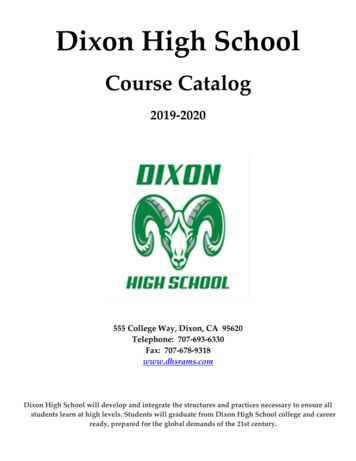
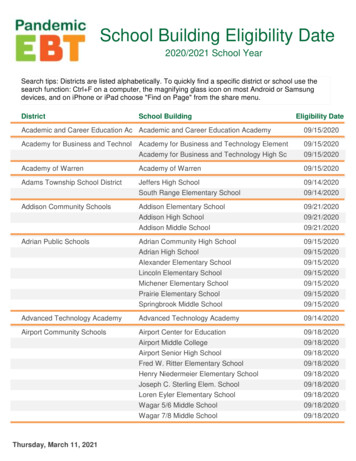
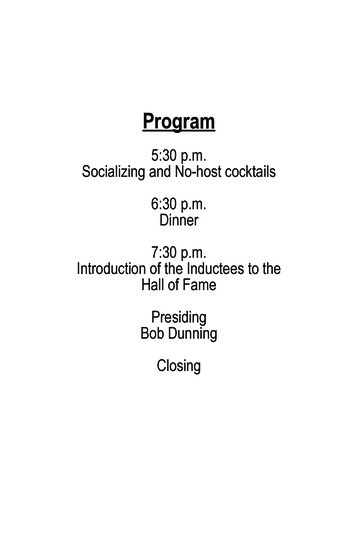

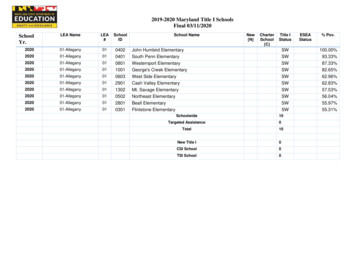

![[403] Vol. Cccxxxviii Over the Counter Sales 3.40 Including G.s.t .](/img/27/22195-gazette-11-may-2022.jpg)
